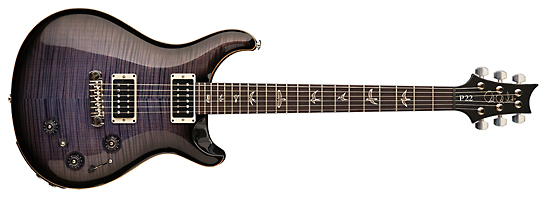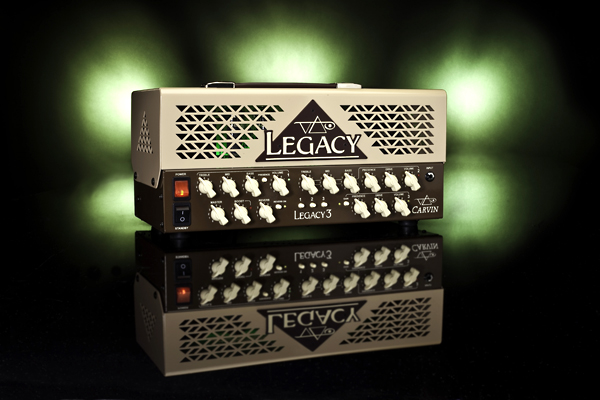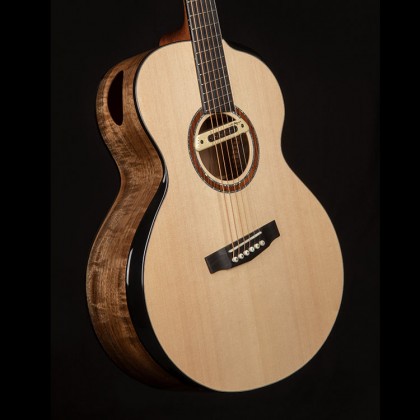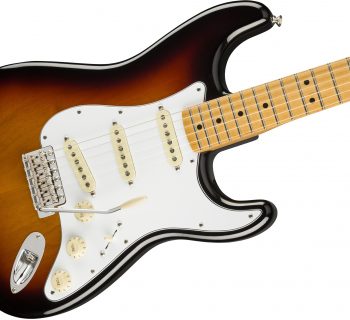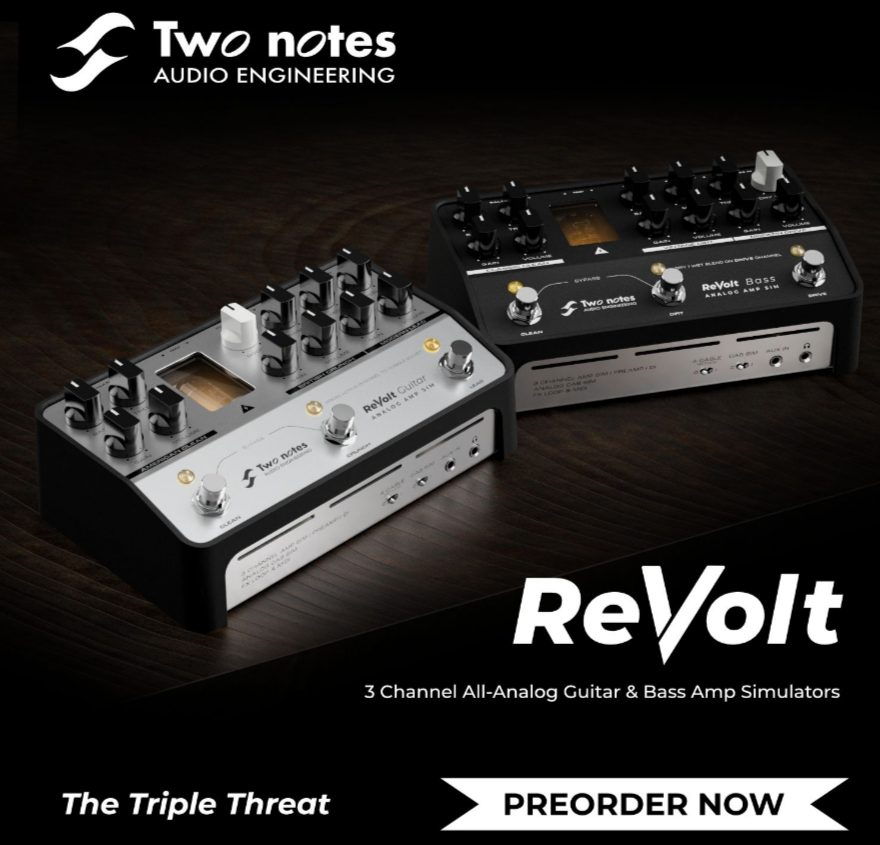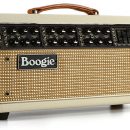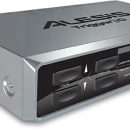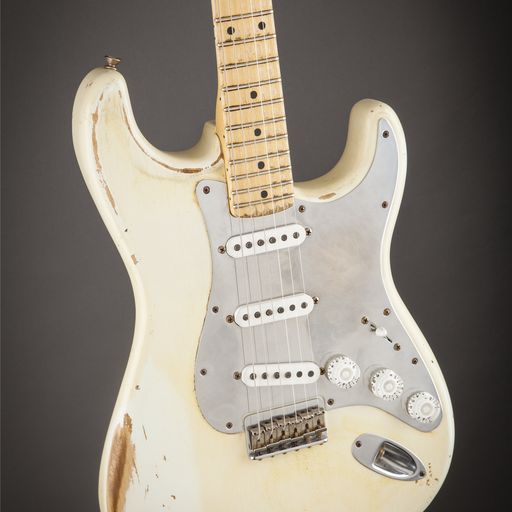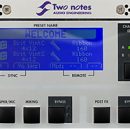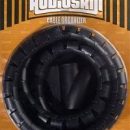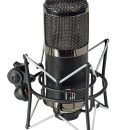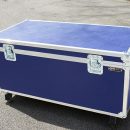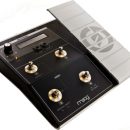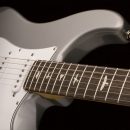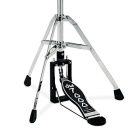 We have been big fans of PRS guitars for years. Their craftsmanship, playability and beauty are simply world class. In fact, our personal collections include PRS guitars, namely the benchmark Custom 22 and 24 models. So when the new P22 arrived at our offices for review it was received with great glee and expectation and a lofty standard to live up to—and it did not disappoint.
We have been big fans of PRS guitars for years. Their craftsmanship, playability and beauty are simply world class. In fact, our personal collections include PRS guitars, namely the benchmark Custom 22 and 24 models. So when the new P22 arrived at our offices for review it was received with great glee and expectation and a lofty standard to live up to—and it did not disappoint.
Sporting the first Piezo system on any PRS solid-body guitar, the P22 took us on a wild ride of schizophrenia from its warm and authentic acoustic tones to the rockin’ sounds of the new 53/10 humbuckers, which may just happen to be our favorite PRS pickups ever (lofty praise indeed, as we are big fans of the HFS and Dragon II models).
| Category | Value | Rating |
| Features | 20% | |
| Usability | 25% | |
| Sound | 25% | |
| Documentation & Support | 10% | |
| Price | 20% | |
| OVERALL RATING =3.6, which earns it a WIHO Award! 3.6 stars or better: Outstanding, WIHO Award 3 stars or better: Worth considering 2 stars or better: Suited to specific needs 1 star or less: Not recommended |
||
Couple the versatile sonic palate with excellent playability, build quality and stunning looks, it’s easy to envision the PRS P22 as the go-to guitar for countless discerning players, including (presumably) a few of us.
Features
The new P22 is the first PRS solid-body guitar to feature the new, compact Piezo bridge designed in conjunction with L.R. Baggs. This bridge is similar in electrical design to those featured in PRS hollow-body models, the key difference being the compact size which allows it to fit neatly and unobtrusively into solid-body guitars. The Piezo bridge, combined with a pair of PRS 53/10 treble and bass pickups, provide the player with an array of tonal possibilities.
The Piezo system operates in two distinct modes, “Mix/Mag” output and “Discreet Output,” based on whether or not you connect instrument cables to one or both output jacks. Plugging into the guitar’s Mix/Mag input allows you to hear both the 53/10 (uncovered) magnetic pickups and the Piezo system using a single mono guitar cable. A mini-toggle System Selector Switch selects magnetic, Piezo, or both systems and the Blend control rotary knob allows the player to adjust the mix or “blend” of the two pickup types.
 In “Discreet Mode” the signal from the magnetic pickups is now sent to one output jack and the Piezo signal is sent to the other. In this mode you can use two mono guitar cables, sending the magnetic pickup output to a guitar amp and the Piezo output to an acoustic guitar amp, PA system, or a mixing board console. In this mode, the rest of the controls remain the same with the exception of what was the Blend control rotary knob in Mix/Mag mode now becomes a dedicated volume knob for the Piezo output.
In “Discreet Mode” the signal from the magnetic pickups is now sent to one output jack and the Piezo signal is sent to the other. In this mode you can use two mono guitar cables, sending the magnetic pickup output to a guitar amp and the Piezo output to an acoustic guitar amp, PA system, or a mixing board console. In this mode, the rest of the controls remain the same with the exception of what was the Blend control rotary knob in Mix/Mag mode now becomes a dedicated volume knob for the Piezo output.
Rounding out the electronics is a battery holder that contains a single 9-volt battery to power the Piezo system as well as six micro-adjustable pots for fine tuning string volume balance (although PRS suggests you leave this adjustment to a qualified repairman).
Magnetic pickup selection is handled via a 5-way blade style toggle switch, which should be familiar to anyone who has wielded a Strat-style guitar. It’s an absolute godsend for those of us who never came to appreciate the PRS 5-way rotary knob switching system.
Our P22 evaluation model also featured a lovely (as well as glossy and aromatic!) carved, figured Maple “10 top” with a Mahogany back, a 22 fret, 25” scale “Pattern Regular” neck with rosewood fingerboard and bird inlays, PRS Phase III tuning machines, and a fully adjustable stop-tail bridge.
Usability
We intentionally placed our P22 in the hands of a few players that are unfamiliar with Piezo-equipped guitars and in particular the L.R. Baggs style system installed on our evaluation guitar. The idea was to see how intuitive the system is to first time users. The consensus was that the system operates as described with nary a tutorial necessary (although a well written explanation is included as part of the guitar’s documentation). The ability to mix or choose one of the distinct modes is easy and intuitive and the controls are strategically/logically placed.
 We should add that we are big fans of PRS-branded pots, which are extremely low friction and easy to spin. This made volume swells easy to pull off and both the volume and tone controls feature a very even taper and roll-off.
We should add that we are big fans of PRS-branded pots, which are extremely low friction and easy to spin. This made volume swells easy to pull off and both the volume and tone controls feature a very even taper and roll-off.
A guitar’s action is always subjective, but in the case of our evaluation model, the action was extremely high from the factory and our review team felt a setup was in short order. Luckily, the stop-tail bridge was fully adjustable and by slackening the strings and turning the two screws located on each side of the bridge, we were able to dial in an action low enough to play comfortably, yet high enough to allow for string bending as well as remain free from buzzing and “fret out.” After this minor adjustment we were quite pleased with the playability of the P22, which was reminiscent of the beloved Custom 22 and 24 models we personally own. Intonation was accurate in all positions and the guitar’s tuning stability was second to none, not even wavering a single “cent” after aggressive bends!
As mentioned earlier, a 5-way blade style pickup selector switch replaces the 5-way rotary knob switching system included on earlier PRS models, and it worked beautifully for us. Even if we preferred the older rotary pickup selector, the blade configuration is more practical on this guitar since you have an additional volume/blend knob to content with due to the inclusion of a Piezo system.
When routing guitar signals to two amps, the three-way mini toggle worked well. In its down/right position, the guitar only sent its magnetic pickup output to our guitar amps. Flipped to the up/left position, we heard only the Piezo output through our PA system, and the middle position sent both outputs to the amp and PA system. In this mode, having separate volume control over the Piezo was handy for adjusting the volume of our acoustic tone in relation to our electric guitar tone.
We would have preferred to have a full-sized toggle for output selection located outside of the knob cluster, and favor other implementations of Piezo acoustic output where the toggle switch is positioned more conveniently for rapid, on-the-fly switching without risk of accidentally hitting other knobs or switches on a guitar. That said, this is still a good, useful design that works better than most Piezo-equipped electric guitars.
Sound
As is typically our custom, we tested the P22 through an array of different amps: a Rivera R100, a 1972 Marshall Super Lead, an Engl Powerball II, and a 2010 Mesa/Boogie “Reborn” Dual Rectifier.
Similar to PRS guitars we personally own, the P22 strummed acoustically has a warm and zingy sound—that is to say, warm on the bass strings and zingy and “spritzy” on the treble strings. Being that this is the first PRS solidbody to feature a Piezo system, we were eager to put the system through its paces and see how it compared with other Piezo-equipped electric guitars.
In Discreet mode we sent the magnetic pickups to an Engl Powerball II amp set to clean and the Piezo to a PA system. With the system selector toggle set to Piezo and a few strums later, we were all in agreement that this may be one of the best, if not the best sounding Piezo system we have ever heard in a solid-body electric guitar! The sound is natural, crystalline and authentic – close your eyes and you would swear you were at your favorite coffee shop (or perhaps your favorite pub given the sweet scent of the paint finish). We heard no metallic artifacts nor did the tone get overbearingly trebly or quacky.
In magnetic mode, we really liked the tone of these new 53/10 PRS pickups. PRS pickups have always been a bit of an acquired taste amongst tone chasers. The various models possess a unique character (particularly in the midrange) that may not appeal to all players. Speaking strictly for ourselves, we have always been fans of PRS pickups (especially the Dragon II and HFS models), so we do not need convincing. Although we reserve the right to change our minds once the “Honeymoon” period ends, at the time of this writing the 53/10 pickup set is easily our favorite PRS model to date. The tone is big and bold (whether played “Clean” or “Mean”), has loads of character without over-emphasizing certain frequencies, and most importantly it passes the ultimate litmus paper test: it left us with no desire whatsoever to tinker with replacement pickups!
With the amp set to clean, the bridge pickup sounds clear enough for simple chording yet retains enough pleasant midrange to invoke some “twang” to your favorite country licks. The neck pickup sounds quite nice as well played clean, and it provided a nice platform for some Hendrix-style flights of fancy ala “Wind Cries Mary” and “Little Wing.”
In “Mix/Mag” mode using a single guitar cable, we sent both our Piezo and magnetic pickups to our Rivera R100 amp (one of our favorite “go to” amps for clean tones). Despite the fact that it is recommended to use either a PA system or an acoustic guitar amp to get the most out of the Piezo system, the acoustic tones sound absolutely fabulous chiming through our Rivera with just a touch of reverb added for good measure. Using the blend control, we dialed in a nice hybrid of acoustic/electric tones authentic enough to cover our favorite Zeppelin and Who tunes. With the 5-way blade switch set to both the 2 and 4 positions, we experienced that pleasing “quack,” perfect for dialing in some faux-Strat tones, and it sounded especially nice while engaging in some funk inspired chord comping.
While we appreciate subtlety, we are also self-professed high gain lovers. Plugged into our Mesa/Boogie Dual Rectifier set to modern high gain mode, we heard the other side of this versatile guitar – the bombastic side! The 53/10 pickups straddle a line between vintage hot and modern high output. Under high gain, the bridge pickup maintains enough clarity to hear both the crack of the pick on the strings and the individual notes of complex chords, as well as provide just enough compression and midrange in a pleasing way.
Single notes trail off and decay almost as if a half-cocked wah is in the signal chain, while palm muted chords chug with plenty of low end thunder. The neck pickup offers more of the same goodness, with a flutey, violin-like presence on sustained treble notes and an almost cello-like low end. Plugged into our non master volume Marshall Super Lead, the 53/10 set provided enough output to drive the amp into full saturation, allowing us to cop some convincing Bad Company and Free tones. With the toggle in the 2 and 4 positions, single note soloing was quite vocal, almost Carlos Santana-like. However, the middle position (the bridge and neck pickup combined) did not really inspire us. We felt it lacked some presence compared to the classic middle position Les Paul tone we are accustomed and compelled to compare it with.
Documentation and Product Support
An electric guitar does not really require an owner’s manual, however, we were pleased to see that a very well written and informative Piezo system manual was included in the case for the benefit of players who may not be familiar with this type of system. Also included in the case is a PRS sticker, the necessary tools for adjustments, extra string retainers, and oddly enough, a Tremolo bar!
Price
The P22 carries a hefty MSRP of $5,230 but can be had on the street for approximately $3,100. This is a fairly typical price for a premium-grade professional guitar, especially one that includes a Piezo system and the high level of craftsmanship that PRS guitars are noted for.
Contact Information
PRS Guitars
www.prsguitars.com
| Evaluation Short-List |
|

